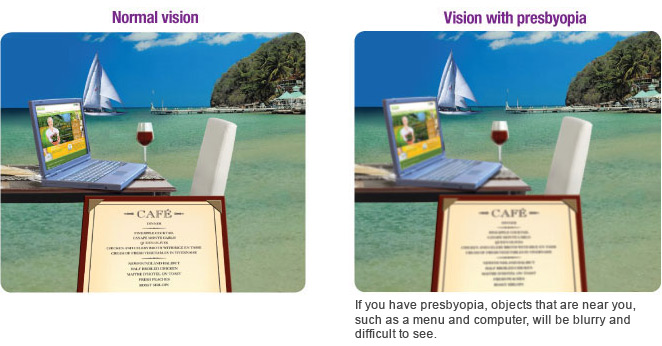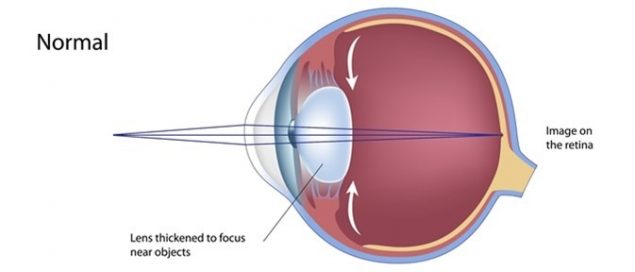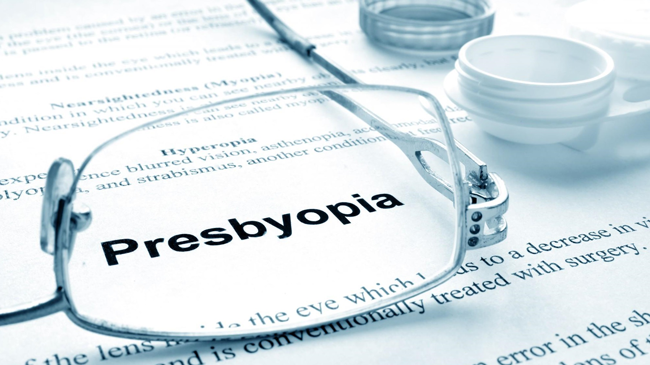
Presbyopia is the normal loss of near focusing ability that occurs with age. Most people begin to notice the effects of presbyopia sometime after age 40, when they start having trouble seeing small print clearly — including text messages on their phone.
You can’t escape presbyopia, even if you’ve never had a vision problem before. Even people who are nearsighted will notice that their near vision blurs when they wear their usual eyeglasses or contact lenses to correct distance vision.
When you become presbyopic, you either have to hold your smartphone and other objects and reading material (books, magazines, menus, labels, etc.) farther from your eyes to see them more clearly. Unfortunately, when you move things farther from your eyes they get smaller in size, so this is only a temporary and partially successful solution to presbyopia.

Also, even if you can still see pretty well up close, presbyopia can cause headaches, eye strain and visual fatigue that makes reading and other near vision tasks less comfortable and more tiring.
Presbyopia is caused by an age-related process. This differs from astigmatism, nearsightedness and farsightedness, which are related to the shape of the eyeball and are caused by genetic and environmental factors. Presbyopia generally is believed to stem from a gradual thickening and loss of flexibility of the natural lens inside your eye.
These age-related changes occur within the proteins in the lens, making the lens harder and less elastic over time. Age-related changes also take place in the muscle fibers surrounding the lens. With less elasticity, the eye has a harder time focusing up close. Other, less popular theories exist as well.


Eyeglasses with progressive lenses are the most popular solution for presbyopia for most people over age 40. These line-free multifocal lenses restore clear near vision and provide excellent vision at all distances, regardless of what refractive errors you may have in addition to presbyopia.
Another option is eyeglasses with bifocal lenses. But bifocals are much less popular these days because they provide a more limited range of vision for many presbyopes. Also, most people don’t want to show their age by wearing eyeglasses that have a visible bifocal line.
Also, it’s common for people with presbyopia to notice they are becoming more sensitive to light and glare due to aging changes in their eyes. Photochromic lenses, which darken automatically in sunlight, are a good choice for this reason. They are available in all lens designs, including progressive lenses and bifocals.
Reading glasses are another choice. Unlike bifocals and progressive lenses, which most people wear all day, reading glasses are worn only when needed to see close objects and small print more clearly.
If you wear contact lenses, your eye doctor can prescribe reading glasses that you wear while your contacts are in. You may purchase readers over-the-counter at a retail store, or you can get higher-quality versions prescribed by your eye doctor.

Regardless which type of eyeglasses you choose to correct presbyopia, definitely consider lenses that include anti-reflective coating. AR coating eliminates reflections that can be distracting and cause eye strain. It also helps reduce glare and increase visual clarity for night driving.
Don’t want to wear eyeglasses or contact lenses for presbyopia? A number of surgical options to treat presbyopia are available as well.
One presbyopia correction procedure that’s gaining popularity is implantation of a corneal inlay. Typically implanted in the cornea of the eye that’s not your dominant eye, a corneal inlay increases depth of focus of the treated eye and reduces the need for reading glasses without significantly affecting the quality of your distance vision.
Other options for surgical correction of presbyopia include:
The first step to see if you are a good candidate for presbyopia surgery is to have a comprehensive eye exam and a consultation with a refractive surgeon who specializes in the surgical correction of presbyopia.
Source.Allaboutvision